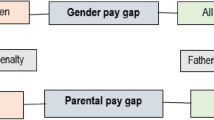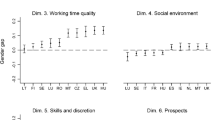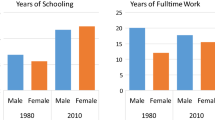Abstract
This study takes a cross-cultural approach to the examination of gender-based pay differentials and career paths, particularly comparing Europe, the USA and Japan. Results indicate that despite increased participation of women in the workforce and their substantial inroads into managerial and professional jobs, gender-based pay gaps persist across borders. However, patterns of the work—family relationship and the impact of gender on earnings differ considerably among industrial societies. Data show that the magnitude of gender-based pay differentials is unrelated to a country’s degree of economic development among the Western industrial societies. Factors that influence pay equity and career paths range from contextual and organizational variables such as cultural norms, types of welfare state regimes and corporate practices related to individual differences in gender, family, education and career choices. The “business case” argument for gender equity and family-friendly policies is linked to the national context. Cultural norms about gender roles and types of welfare state regimes pertaining to the role of the state in statutory provisions help explain trends and developments in gender-based pay adjustments and variations at the firm level. Gender pay gaps are likely to be larger — and to be narrowed more slowly — in masculinity-oriented societies than in femininity-oriented societies.
Access this chapter
Tax calculation will be finalised at checkout
Purchases are for personal use only
Preview
Unable to display preview. Download preview PDF.
Similar content being viewed by others
References
Adler, N. J. (1984). Women in international management: Where are they? California Management Review, 26 (6), 78–89.
Arthur, M. B. (1994). The boundaryless career: A new perspective for organizational inquiry. Journal of Organizational Review, 15, 295–306.
Arulampalam, W., Booth, A. L., & Bryan, M. L. (2007). Is there a glass ceiling over Europe? Exploring the gender pay gap across the wage distribution. Industrial and Labor Relations Review, 60 (2), 163–182.
Blau, F. D., & Kahn, L. M. (1992). The gender earnings gap: Learning from the international comparisons. American Economics Review, 82 (2), 533–538.
Blau, F. D., & Kahn, L. M. (2003). Understanding international differences in the gender pay gap. Journal of Labor Economics, 21 (1), 106–144.
Blau, F. D.. & Kahn, L. M. (2007). The gender pay gap. The Economists’ Voice, 4 (4), 1–6.
Brewster, C. (1988). The Management of Expatriates. Human Resource Research Centre Monograph Series, N 2.
Brookfield, G. R. S. (2010). Global Relocation Trends, 2010 Survey Report, Brookfield Relocation Services, LLC.
Carley, M. (2009). Widening of gender pay gap triggers calls for action, European Industrial Relations Observations Online, page last updated: 12 January 2009, Spire Associates/IRRU, University of Warwick, retrieved on 3 August 2010 from http://www.eurofound.europa.eu/eiro/2008/12/articles/uk0812029i.htm.
De la Rica, S., Dolda, J. J., & Llorens, V. (2005). Ceiling and floors: Gender wage gap by education in Spain. Bonn, Germany: IZA Distribution Paper 1483.
den Dulk, L. (2001). Work-Family Arrangements in Organizations: Across-National Study in the Netherlands, Italy, the United Kingdom, and Sweden. Amsterdam: Rozenberg Publishers.
Dowling, P. J., & Welch, D. E. (2005). International Human Resource Management: Managing People in a Multinational Context, 2nd edition. Thomson/South-Western Corporation, OH: Mason.
Esping-Andersen, G. (1990). The Three Worlds of Welfare Capitalism. Cambridge: Polity Press.
Esping-Andersen, G. (1999). Social Foundations of Postindustrial Economies. New York: Oxford University Press.
European Commission. (2011). Report on Progress of Equality between Women and Men in 2010. Luxemburg: Publications Office of the European Union.
European Foundation. (2001). Gender perspectives — annual update 2000. European Industrial Relations Observatory Online, retrieved on 17 March 2003 from www.eiro.eurofound.ie/2001/03/update/TN0103201U.html.
European Foundation. (2002a). Pay developments annual update, European Industrial Relations Observatory Online, retrieved on 3 August 2010 from www.eiro.eurofound.ie/2002/02/update/tn0202102u.html.
European Foundation. (2002b). Gender pay equity in Europe. European Industrial Relations Observatory Online, retrieved on 17 March 2003 from www.eiro.eurofoundle/2002/01/study/tn0201101S.html.
European Foundation. (2004). Pay developments — 2003, European Industrial Relations Observatory Online, retrieved on 19 September 2005 from www.eiro.eurofound.int/2004/03/update/tn0403103u.html.
European Foundation. (2007). Gender and Career Development. European Foundation for the Improvement of Living and Working Conditions, Dublin, Ireland, May 31.
European Foundation. (2010). Addressing the gender pay gap: Government and social partner actions. European Foundation for the Improvement of Living and Working Conditions, Dublin, Ireland, April 27.
Eurostat. (2008). European Union Labour Force Survey — Annual Results 2007. European Commission, Luxemburg: Publications Office of the European Union.
Eurostat. (2010). Europe in Figures — Eurostat Yearbook 2010. European Commission, Luxemburg: Publications Office of the European Union.
Frone, M. R. (2003). Work-family balance. In: J. C. Quick & L. E. Tetrick (eds.), Hand-book of Occupational Health Psychology. Washington, DC: American Psychological Association.
GMAC Global Relocation Services. (2002). Global Relocation Trends: 2002 Survey Report.
GMAC Global Relocation Services/Windham International. (2005). Global Relocation Trends: 2005 Survey Report.
Hall, D. T. (1987). Career and socialization. Journal of Management13 (2), 301–321.
Hall, D. T., & Moss, J. E. (1998). The new protean career contract: Helping organizations and employees adapt. Organizational Dynamics, 26 (3), 22–37.
Hamill, J. (1989). Expatriate policies in British multinationals. Journal of General Management, 14 (4), 19–33.
Hofstede, G. (1980). Culture’s Consequences: International Differences in Work Related Values. Beverly Hill: Sage Publications.
Hofstede, G. (1997). Cultures and Organizations: Software of the Mind, 2nd edition. New York: The McGraw-Hill Companies, Inc.
Hofstede, G. (2001). Culture’s Consequences: Comparing Values, Behaviors, Institutions, and Organizations Across Nations, 2nd edition. Thousand Oaks: Sage Publications.
Hori, H. (2009). Labor market segmentation and gender the wage gap. Japan Labor Review, 6 (1), 5–20.
Jameson, S. (2001). Liberation limbo, Asian Business, January: 64.
Japanese Ministry of Health, Labor and Welfare. (2004). Basic Surveys on Wage Structure.
Jiji Press English News Service. (2002). Some 40 percent of Japan’s working women part-timers. March 27: 1.
Kinnunen, U., & Mauno, S. (1998). Antecedents and outcomes of work-family conflict among employed women and men in Finland. Human Relations, 51, 157–177.
Kraemer, B. (2010). Gender pay gap shown to exist even at start of career, European Industrial Relations Observations Online, 18 January 2010, Institute of Economic and Social Research, WSI, retrieved on 3 August 2010 from http://www.eurofound.europa.eu/eiro/2009/12/articles/de0912029i.htm.
Marx, E. (1996). International Human Resources Practices in Britain and Germany. London: Anglo-German Foundation.
Mayrhofer, W., Steyrer, J., Meyer, M., Strunk, G., Schiffinger, M., & Iellatchitch, A. (2005). Graduates’ career aspirations and individual characteristics. Human Resource Management Journal, 15 (1), 38–56.
McGrath, M., Driscoll, M., & Gross, M. (2005). Back in the Game: Executive Summary. Wharton Centre for Leadership and Change Management, University of Pennsylvania: Knowledge at Wharton, Philadelphia.
Millar, J., & Warman, A. (1996). Family Obligations in Europe. London: Family Policy Studies Center.
Näman, E. (1999). Sweden and the reconciliation of work and family life. In: L. den Dulk, J. van Doorne-Huiskes & J. Schippers (eds.), Work-Family Arrangements in Europe. Amsterdam: Thela-Thesis.
OECD. (1973). Manpower Policy in Japan. Paris: OECD.
OECD. (2008). OECD Employment Outlook 2008 — Statistic Annex. Paris: OECD.
ORC. (2003). Dual-careers and International Assignments Survey 2002. Organizational Resources Counselors.
Reitman, F., & Schneer, J. A. (2005). The long-term negative impacts of managerial career interruptions: A longitudinal study of men and women MBAs. Group & Organization Management, 30, 243–262.
Schein, E. H. (1984). Culture as an environmental context for careers. Journal of Occupational Behavior, 5, 71–81.
Sainsbury, D. (1996). Gender, Equality and Welfare States. Cambridge: Cambridge University Press.
Schneer, J. A., & Reitman, F. (1993). Effects of alternative family structures on managerial career paths. Academy of Management Journal, 36 (4), 830–843.
Shuto, W. (2009). Occupational sex segregation and the Japanese employment model: Case studies of the railway and automobile industries. Japan Labor Review, 6 (1), 21–35.
Trifiletti, R. (1999). Work-family arrangements in Italy. In: L. den Dulk, J. van Doorne-Huiskes & J. Schippers (eds.), Work-Family Arrangements in Europe. Amsterdam: Thela-Thesis.
Tung, R. L. (1981). Selection and training of personnel for overseas assignments. California Journal of World Business, 6 (1), 68–78.
US Census Bureau. (2008). Men’s and Women’s Earnings by State: 2008 American Community Survey, Economics and Statistics Administration, U.S. Department of Commerce.
US Census Bureau. (2009). Men’s and Women’s Earnings by State: 2008 American Community Survey. US Department of Commerce Economics and Statistics Administration, issued September 2009.
USDOL BLS. (2001). Highlights of women’s earnings in 2000, U.S. Department of Labour, Bureau of Labour Statistics, August: Report 952.
USDOL BLS. (2004). Women in the labour force: A databook, U.S. Department of Labour, Bureau of Labour Statistics, February: Report 973.
USDOL BLS. (2005). Women in the labour force: A databook, U.S. Department of Labour, Bureau of Labour Statistics, May: Report 985.
USDOL BLS. (2009). Women in the labour force: A databook, U.S. Department of Labour, Bureau of Labour Statistics, September: Report 1018.
USDOL BLS. (2010). Highlights of women’s earnings in 2009, U.S. Department of Labour, Bureau of Labour Statistics, June: Report 1025.
Wood, R. G., Corcoran, M. E., & Courant, P. N. (1993). Pay differences among highly paid: The male-female earnings gap in lawyers’ salaries. Journal of Labor Economics, 11 (3), 417–441.
Yang, N. (2005). “Individualism-collectivism and work-family interfaces: A SINO-U.S. comparison”. In: S. A. Y. Poelmans (ed.), Work and Family: An International Research Perspective (pp. 287–318). Mahwah, NJ: The Lawrence Erlbaum Associates. Inc.
Yang, N. (2007). A cross-cultural contextual model of work-family interfaces in managing international assignments. Journal of International Business Research, 6 (1), 1–14.
Yang, N., Chen, C. C., Choi, J., & Zou, Y. (2000). Sources of work-family conflict: A SINO-U.S. comparison of work and family demands. Academy of Management Journal, 43 (1), 113–123.
Zellner, W. (2003). No way to treat a lady? Business Week, March 3: 63–66.
Author information
Authors and Affiliations
Editor information
Editors and Affiliations
Copyright information
© 2013 Nini Yang
About this chapter
Cite this chapter
Yang, N. (2013). Effects of Gender and Family on Earnings and Career Paths: A Cross-Cultural Study of Europe, the USA and Japan. In: Poelmans, S., Greenhaus, J.H., Maestro, M.L.H. (eds) Expanding the Boundaries of Work-Family Research. Palgrave Macmillan, London. https://doi.org/10.1057/9781137006004_6
Download citation
DOI: https://doi.org/10.1057/9781137006004_6
Publisher Name: Palgrave Macmillan, London
Print ISBN: 978-1-349-43491-6
Online ISBN: 978-1-137-00600-4
eBook Packages: Palgrave Business & Management CollectionBusiness and Management (R0)




